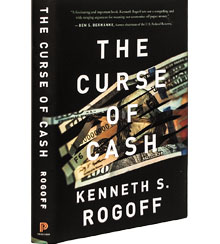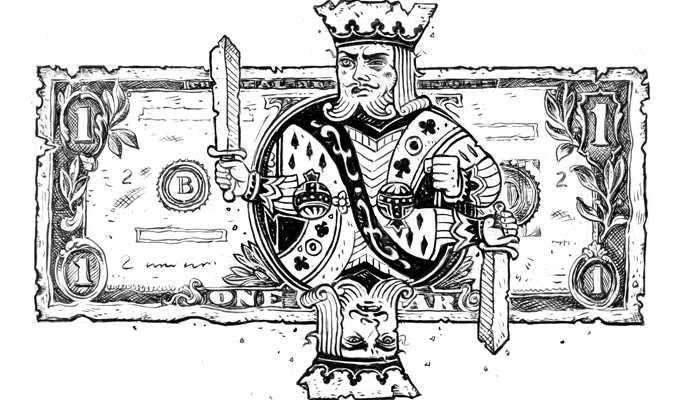Cash Advances?
Economist Kenneth Rogoff argues that getting rid of paper money will lead to a more secure economy and effective monetary policy.
A version of this article appeared in the Spring 2017 issue of strategy+business.
The Curse of Cash
by Kenneth S. Rogoff, Princeton University Press, 2016
This spring, the European Central Bank announced it would phase out the €500 note. If you have never seen one, you are not alone. The value of having a single note worth that much money — about US$560 — is clear to only a limited demographic. If you want to buy a Kalashnikov rifle with just a couple of bills, or maybe discreetly tip your sommelier in Saint-Tropez, it may be the banknote for you. For ordinary folks, though, it’s not a big loss. The truth is that €500 notes have little value in the licit economy.
In The Curse of Cash, Harvard economist Kenneth S. Rogoff, best known for his study of financial crises, This Time Is Different (coauthored with Carmen Reinhart), proposes a much more dramatic move. If it makes sense to get rid of extra-large bills like the €500 and Canada’s $1,000 note, why not do away with all paper money? It’s a striking and provocative idea, well worth a public hearing, and likely points in the direction the world is headed — though it will probably take a few decades longer to get there than Rogoff would like.
The Curse of Cash is really two short books: one aimed at general readers, and one for economists and others with a strong interest in economic theory. The first gives an overview of the use of cash, exploring some of its puzzles and many of its misuses. The second focuses on the economic problem of negative interest rates.
The best way to see the strengths and weaknesses of Rogoff’s case for doing away with cash is to start with the second, more technical part. This is where Rogoff’s greatest insights lie, and that’s to his credit — economists should be at their best when they are talking economics. Rogoff tackles what’s technically known as the “zero bound problem,” or in simpler terms, how central banks can lower interest rates below zero.
When much of the current thinking on monetary policy was developed, during the 1930s through 1970s, the biggest threat central banks were asked to combat was inflation. And in an environment of high inflation, stimulating the economy is easy: lower interest rates to push savings into productive uses.
But what happens if inflation is low and interest rates have already hit zero? That’s pretty much where we’ve been since the financial crisis of 2008. Essentially, Rogoff argues that if we could lower interest rates below zero — effectively taxing cash — central banks would have much more powerful measures to spur recovery in times of crisis. He makes a good case that although taxing cash wouldn’t endear the Fed to savers, the Fed has taken politically tougher steps to get out of crises.
The only obstacle? Cash. It would be very hard to put Rogoff’s theory into practice as long as savers could just turn their money into paper money. After all, if inflation is zero and government bonds pay, say, a –2 percent (or even –4 percent interest rate), why not just store your money in high-value bills?
Which brings us to the first part of Rogoff’s book. He understands that getting rid of cash — starting with $100 bills and working down — is not exactly an easy sell. So Rogoff builds the case against cash, loading up on all the things wrong with paper money.
The main thing: Paper money is the oil that greases the machinery of illegality. If you are buying drugs or taking bribes, cash is your friend. If you are collecting the proceeds of illegal activity, big bundles of Benjamins are an excellent means of storage. And bribery or drug sales are only the darkest edges of a much larger, hidden, cash-based economy. Rogoff estimates that Europe and the U.S. alone lose hundreds of billions of dollars in tax revenue annually due to cash transactions.
If you are collecting the proceeds of illegal activity, big bundles of Benjamins are an excellent means of storage.
Rogoff’s case against cash is so cogently argued that it’s hard to believe that we haven’t already gotten rid of paper bills and coins — or at least larger bills. And there is the rub, and where Rogoff’s book skims over what should be some of the most interesting terrain. He devotes only three sentences to “adjusting regulation” — one of the shortest sections of the book. Yet this is almost certainly the toughest aspect of transitioning away from cash.
As The Curse of Cash repeatedly points out, Sweden has been moving quickly toward cashlessness, eliminating large bills and cutting the amount of paper currency in circulation. Clearly the shift is possible, and slowly — oh, ever so slowly — the rest of the world has been moving in this direction. (Witness the €500 note’s death.)
But Sweden has a very different regulatory regime than the United States does. It has different attitudes toward financial disclosure; how much you pay in taxes in Sweden, for instance, is public record. It has different tax structures, and different attitudes toward undocumented immigrants (it has a great many immigrants, and almost all are there legally). And it’s not clear how much political appetite there is in the United States for shutting down the gray economy of cash in the short time frame that Rogoff envisions.
The Curse of Cash has all the strengths you expect of a book from an economist. When it comes to figuring out how central banks would move away from cash, Rogoff is careful, polished, and detailed, even including a chart-filled technical appendix. On the politics, though, Rogoff punts, effectively saying that we don’t need to sweat the details. That’s too bad, because that’s where all the little devils who kill big ideas tend to hide.
Author profile:
- Mark Gimein is a writer and editor in New York. He writes regularly about the economy for NewYorker.com and Time.com, and blogs at Chumpchanger.com.



